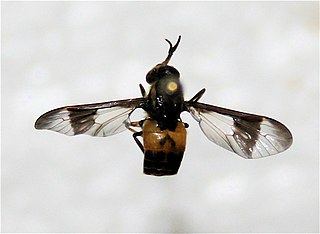Harold Oldroyd (24 December 1913 – 3 September 1978) was a British entomologist. He specialised in the biology of flies, and wrote many books, especially popular science that helped entomology to reach a broader public. His The Natural History of Flies is considered to be the "fly Bible". Although his speciality was the Diptera, he acknowledged that they are not a popular topic: "Breeding in dung, carrion, sewage and even living flesh, flies are a subject of disgust...not to be discussed in polite society". It was Oldroyd who proposed the idea of hyphenating the names of true flies (Diptera) to distinguish them from other insects with "fly" in their names. Thus, the "house-fly", "crane-fly" and "blow-fly" would be true flies, while the "dragonfly", "scorpion fly" and so on belong to other orders. He also debunked the calculation that a single pair of house-flies, if allowed to reproduce without inhibitions could, within nine months, number 5.6×1012 individuals, enough to cover the Earth to a thickness of 14.3 m (47 ft). Oldroyd calculated that such a layer would only cover Germany, but remarked "that is still a lot of flies".

Chrysops caecutiens, common name splayed deer fly, is a species of horse fly belonging to the family Tabanidae. It is also known by the colloquial name Scotch Cleg.

Chrysops callidus is a species of deer fly in the family Tabanidae.

Chrysopsinae is an insect subfamily in the family Tabanidae commonly known as deer flies or sheep flies and are bloodsucking insects considered pests to humans and cattle. They are large flies with large brightly-coloured compound eyes, and large clear wings with dark bands. They are larger than the common housefly and smaller than the horse-fly.

Chrysops geminatus is a species of deer fly in the family Tabanidae.
Chrysops indus is a species of deer fly in the family Tabanidae.
Chrysops montanus is a species of deer fly in the family Tabanidae.
Chrysops divisus is a species of deer fly in the family Tabanidae.
Chrysops mitis is a species of deer fly in the family Tabanidae.

Chrysops flavidus is a species of deer fly in the family Tabanidae. The species is identifiable by its yellow legs.
Chrysops furcatus is a species of deer fly in the family Tabanidae.
Chrysops frigidus is a species of deer fly in the family Tabanidae.
Whitneyomyia is a genus of horse flies in the family Tabanidae. There is at least one described species in Whitneyomyia, W. beatifica.
Chrysops moechus is a species of deer fly in the family Tabanidae.
Chrysops sordidus is a species of deer fly in the family Tabanidae.
Chrysops ater is a species of deer fly in the family Tabanidae.

Chrysops vittatus is a species of deer fly in the family Tabanidae.
Chrysops aestuans is a species of deer fly in the family Tabanidae.
Chrysops delicatulus is a species of deer fly in the family Tabanidae.






